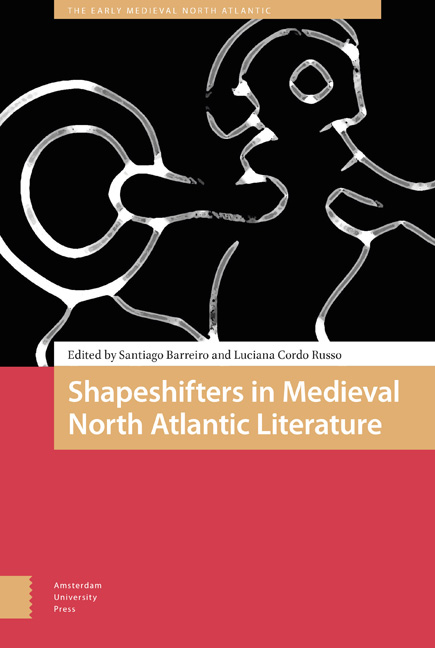Book contents
- Frontmatter
- Contents
- Acknowledgments
- Introduction: Medieval Thought and Shapeshifting
- 1 Wundor wearð on wege‘a wonder happened on the way’: Shifting shapes and meanings in Old English Riddles
- 2 The Big Black Cats of Vatnsdalr and Other Trolls: Talking about shapeshifting in medieval Iceland
- 3 The Hoard Makes the Dragon: Fáfnir as a Shapeshifter
- 4 Eigi í mannligu eðli: Shape, Monstrosity and Berserkism in the Íslendingasögur
- 5 The Cursed and the Committed: A Study in Literary Representations of ‘Involuntary’ Shapeshifting in Early Medieval Irish and Old Norse Narrative Traditions
- 6 Unde sunt aues istae?: Notes on Bird-Shapeshifting, Bird Messengers, and Early Medieval Hagiography
- 7 Sin, Punishment, and Magic: Changing Form in Medieval Welsh Literature
- Index
5 - The Cursed and the Committed: A Study in Literary Representations of ‘Involuntary’ Shapeshifting in Early Medieval Irish and Old Norse Narrative Traditions
Published online by Cambridge University Press: 16 February 2021
- Frontmatter
- Contents
- Acknowledgments
- Introduction: Medieval Thought and Shapeshifting
- 1 Wundor wearð on wege‘a wonder happened on the way’: Shifting shapes and meanings in Old English Riddles
- 2 The Big Black Cats of Vatnsdalr and Other Trolls: Talking about shapeshifting in medieval Iceland
- 3 The Hoard Makes the Dragon: Fáfnir as a Shapeshifter
- 4 Eigi í mannligu eðli: Shape, Monstrosity and Berserkism in the Íslendingasögur
- 5 The Cursed and the Committed: A Study in Literary Representations of ‘Involuntary’ Shapeshifting in Early Medieval Irish and Old Norse Narrative Traditions
- 6 Unde sunt aues istae?: Notes on Bird-Shapeshifting, Bird Messengers, and Early Medieval Hagiography
- 7 Sin, Punishment, and Magic: Changing Form in Medieval Welsh Literature
- Index
Summary
Abstract
The literary representation of metamorphosis through a curse, or ‘involuntary’ shapeshifting, is found in both the Early Medieval Irish and Old Norse narrative traditions. Both show similarities with a wider worldview of the soul, the body, and transformation in general, and both, surprisingly, adhere to the tropes found in contemporary Christian thinking and writing. By examining the literary evidence, presenting cases of curses, as well as deliberate self-cursing, the study analyses the individual texts and attempts to place them in a wider context of philosophical and Christian ideas of the medieval period.
Keywords: Shapeshifting, curse, Early Irish, Old Norse, Undead
In the following study, which is part of a wider study of shapeshifting, the concept of ‘involuntary’ shapeshifting will be discussed and compared across literary evidence in Early Medieval Irish and Old Norse narrative traditions. The wider study also considers two other concepts of shapeshifting, namely ‘voluntary’ and ‘genetic’. By categorising shapeshifting into these three categories, the literary evidence can be analysed and compared in a consistent way.
When examining shapeshifting, or metamorphosis, it is important to distinguish between metaphorical and literal changes. The literal representations are situations where a character is described as changing shape, not just assuming some animalistic traits. Metaphorical is defined as situations in which the author of a text has used animal imagery to describe or explain human behaviour. Caroline Walker Bynum has identified two types of shapeshifting, the first being metempsychosis, i.e. ‘body hopping, body exchange, or body erasure’, the second being metamorphosis, i.e. the ‘change of one body into another or change of species’. Metempsychosis happens when the soul, or an equivalent interpretation of the soul, leaves the body and inhabits another body or vessel. The soul assumes the physical exterior of the vessel, while keeping the mental interior of the original vessel. Metamorphosis is defined as the whole physical body changing into another, or changing species. In some cases, the mental interior will change too, as with the change of species, where some of the animal characteristics not previously inherent in the shapeshifter are assumed. In others, they remain the same and only the exterior changes. The capacity of human language is often lost when a change of species occurs, taking the shapeshifter to a bestial level. The examples used in this study show cases of metamorphosis only.
- Type
- Chapter
- Information
- Shapeshifters in Medieval North Atlantic Literature , pp. 107 - 126Publisher: Amsterdam University PressPrint publication year: 2018

